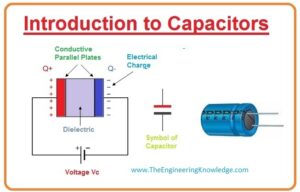 Hello dear students, I hope you all are doing great. In today’s tutorial, we will have a look at Introduction to Capacitor. A capacitor consists of two terminals, it stores electrical power or energy in the shape of the electrical field. There are many types of capacitors but all do the same job storing of charge, all of these has two conductive plates that have a dielectric material in between them. The conductive plates can be of any thin metallic sheet and dielectric material can be of glass, air, or any insulating material.
Hello dear students, I hope you all are doing great. In today’s tutorial, we will have a look at Introduction to Capacitor. A capacitor consists of two terminals, it stores electrical power or energy in the shape of the electrical field. There are many types of capacitors but all do the same job storing of charge, all of these has two conductive plates that have a dielectric material in between them. The conductive plates can be of any thin metallic sheet and dielectric material can be of glass, air, or any insulating material.
Capacitors are extensively used as main components of electrical circuitry in numerous electrical instruments like motors, fans, etc. As we know resistance is the cause of power loss but the capacitor stores power in the shape of an electrical field among their plates. In today’s post, we will have a detailed look at its construction, working, features and some other related parameters. So let’s get started with an introduction to Capacitor
Introduction to Capacitor
- A capacitor consists of two-terminal, it stores electrical power or energy in the shape of an electrical field.
- As we discussed above capacitor has dielectric material among the electric plates this dielectric material do not allow direct current to pass instead it stores voltage in the shape of charge across the plates of a capacitor.
- The metallic plates of a capacitor can be of any shape like circle, rectangle, square, or sphere, in which shape it to be made is depends on its use and at which voltage it has to be used.
- Whenever we use a capacitor in such circuitry which works on direct current insulating material stops the movement of current but it stored charged on plates of a capacitor.
- But, when a capacitor is associated to an alternating current circuit, the movement of the current seems to permit easily through the capacitors with slight or no resistance..
- There are two main kinds of electrical charges first one is positive and the second one is negative.
- When we provide direct current to a capacitor the positive charge stores on a positive electrode (plate) of a capacitor and the negative charge stores on a negative electrode of a capacitor
- For each particle of positive charge which reaches at a positive electrode a charge of a similar sign will leave from the negative electrode.
- Due to this, the electrodes endure neutral charging and a potential change due to this charging is recognized amid the two electrodes of capacitors.
- when the capacitor has its stable state current is incapable of moving over the capacitor and about the circuitry due to the dielectric possessions of the dielectric material used to detach the electrode.
- The motion of electrons over the electrode of the capacitor is recognized as the Charging Current of a capacitor, which flows till that point when applied voltage and voltage across the electrode of the capacitor become equal. This condition is said to be a fully charged condition of a capacitor.
How Energy Stored in Capacitor
- The quantity of potential existing at the capacitor depends on how much amount of charge was stored on the electrodes by the work done by the power supply and it also depends on the capacitance of the capacitor. The given diagram explains this phenomenon.
- In the diagram, we can see a parallel plate capacitor configuration. This capacitor is the basic type of capacitor.
- Two metallic electrodes can make it by putting them at a specific distance, and its capacitance can be measured by area of plate and space between them.
- By changing the distance between capacitors and the area of plate we can change the capacitance of a capacitor which is measured in farad.
- As the capacitor stores the power or energy of moving electrons in the shape of charge on electrodes, so we can say if the area of the plate is larger and the distance between them is smaller then the capacitor stores more charge on plates. Which means it has a larger capacitance.
- By providing a supply to a capacitor and calculating the quantity of charge on plates we can calculate value of capacitance by given formula.
Q/v=C
- it can also be written as Q= C x V
- As we have studied that the charge is a deposit on the electrodes of a capacitor, we can also say that the energy of the charges is deposited in the shape of the electrical field among the two electrodes.
- When current continues to moves through the capacitor it gets charged, so the electrical field also becomes stronger as it supplies more energy among the electrodes.
- Similar to this if current moving out of the capacitor, it starts discharging, and optional alteration amid electrodes getting starts eliminating due to this field stored between plates also decreasing.
What is the Capacitance of Capacitor
- The ability of a capacitor to deposit charge on its electrodes in the shape of an electrical field is known as
- We can also say it that it is a feature of a capacitor that stops the alteration of voltage about it.
- It also is known as the electrical feature of a capacitor and is the capability to store charge among its two electrodes, which has a unit of Farad (F).
- We can also define Capacitance as that if one columb of charge is a deposit on the electrodes of a capacitor in the presence of one volt at its terminal then it has one-farad capacitance.
- The point which is noticeable is that C has positive values and not negative ones.
- FARAD is a very large unit of calculation, so we use its subs units like uF, nF, pF.
How to find Capacitance of a Parallel Plate Capacitor
- The capacitance © of a parallel plate capacitor is proportionate to the area (m2 ) of the smallest plate and inversely proportionate to the distance between the plates which measure in a meter.
- The equation of capacitance of parallel plate capacitors is given below.
C = ε(A/d)
- In this equation (ε) shows the absolute permittivity of the insulating material used between the plates.
- But if there is no medium between the plates or is space in between plates the permittivity is denoted by (εo ) it named as “permittivity of free space” it is constant and has a value of (8.84×10-12 )F/m.
- Normally, the plates of the capacitor are parted away by a specific type of dialectic material instead of air.
What is the Dielectric of a Capacitor
- As we discussed area of the plate and the distance between the plates affect the capacitance of the capacitor.
- Instead of these two parameters one thing is also important which is the material between the plates which also called dielectric. In other words, we can say that Permittivity (ε) of the dielectric.
- The plats of the capacitor are created by any metallic material which permits current to flow but dielectric material is always constructed by an insulator.
- The numerous isolating constituents are used as the insulator in a capacitor which has different abilities to stop of pass charges.
- The insulating components can be created from many insulating materials or mixtures of these ingredients.
- Mostly used insulating materials are air, paper, glass, etc.
- The aspect by which the isolating material, upsurges the capacitance of the capacitor associated to air is recognized as the Dielectric Constant, (k).
- Insulating components with a higher insulating constant is a well dielectric than which has a less dielectric constant.
- (K) is a dimensionless amount as it is comparable to a vacuum.
- The real permittivity of the dielectric among the electrodes is the multiple of the permittivity of vacuum (εo) and the relative permittivity (εr) of the material used between the plates.
εo xεr = ε
Voltage Rating of a Capacitor
- Every capacitor has specific voltage ratings during the selection of a capacitor these parameters are the first considered, either how much voltage we can apply across it.
- The extreme amount of voltage that can be applied across a capacitor is mentioned in the datasheet of a capacitor, so you should always read to apply a voltage across a capacitor.
- If the applied voltage is greater then the specified limit the dielectric material will break down and a short circuit will cause damage the capacitor.
- The operating voltage of the capacitor depends on the dielectric material used and its diameter.
- A capacitor that is needed to work at a hundred V (AC) must have an OPERATING voltage near two hundred V.
- In normal conditions, you should select a capacitor that has a fifty percent larger voltage capacity than its effective voltage to be applied.
- Another main aspect that disturbs the working of a capacitor is for electric leakage current.
- This leakage happens in the capacitor due to the undesired flow of current through the insulating material.
- Usually, it is expected that the resistance of the insulating material is enormously higher and a decent dielectric stops the movement of direct current from one plate to another.
- But, if the insulating substantial gets injured due to extreme voltage or higher temperature, the leak current through the insulator will become very higher subsequent in fast damage of charge on the electrodes and hotness of the capacitor finally subsequent in early damage of the capacitor.
- So always try to use the capacitor under its specified voltage otherwise it will cause serious damage and can be harmful to your expensive device in which you are using it.
How Cloud Capacitors cause Lightning
- When clouds move In the sky their particles collide with air due to their rubbing they get stationary charges in same way as we use a comb in our air.
- The particles of clouds gets a positive charge which is less in weight and lower particles get negative charges which are heavy in weight.
- These partition of charges which created on clouds make capacitor like configuration.
- As clouds always remain in motion due to their motion they cause an effect on things on earth.
- The negative charge lower clouds will repel the negative charge on Earth and generate a positive charge on that specific area of earth,
- The parting of charge among the lowest of the cloud and the earth is behave like a capacitor.
- With the passage of time, huge charges can collect in clouds. If the charges are in a very large amount, the cloud comprises of a huge quantity of potential energy (EE).
- When the voltage becomes too mush higher nearly several thousand volts, then air started behaves like conducting material and current starts to flow through it like other conductors which creat a hug spark which is known as lightening.
Conclusion of Introduction to Capacitor
- In this article, we discussed that the main function of capacitor is to store energy or charges.
- The quantity of charge which can it store depends on the capacitance of capacitor which depends on three main factors which discussed below.
Area:
- it is area A of plates, if it is greater than the ability of a capacitor to store charge is larger.
Distance between plate:
- If the space between the plate is lesser then the capacitance will be greater.
Insulating Material :
- capacitance also depends on the material of insulator if it has high permittivity then capacitance will be larger.
- We have also discussed that a capacitor comprises of metallic plates which do not touch one other but are parted by a substance named as a dielectric.
- The insulating can be of any non-conducting material like air, glass or mica sheets.
- These are some advantages dielectric:
- The (k) is the ability of the insulating substance it is different for different materials.
- The insulating material offers automatic control among the two electrodes letting the plates to be nearer to each other without colliding.
- The permittivity of the dielectric substance upsurges the capacitance.
- The dielectric materials upsurge the extreme working voltage associated to air.
Applications of Capacitor
- It can be used in many instruments and circuitries to block direct current and allows other signals to pass on.
- Its feature of stoppage makes it effective to use in different circuits to remove undesired surges in voltage or waveform.
- It can also be used to regulate the frequency retort of an acoustic circuitry or to combine different discrete amplifier circuits that should be endangered from the communication of direct current.
- It can also be used in different rectification circuits to reduce ripples in direct current.
- It also used in fans to provide starting current.
- It also used in different motors instead of starting winding which reduces the cost of motors.
So, friends, it is a detailed post about the capacitor if you have any questions ask in the comments. Thanks for reading.


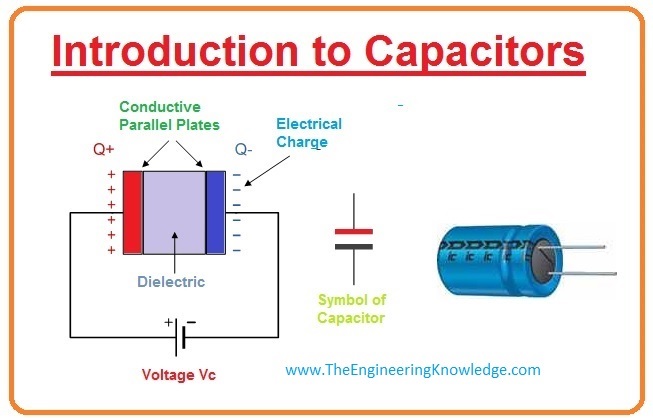
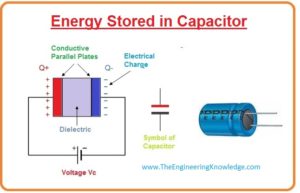
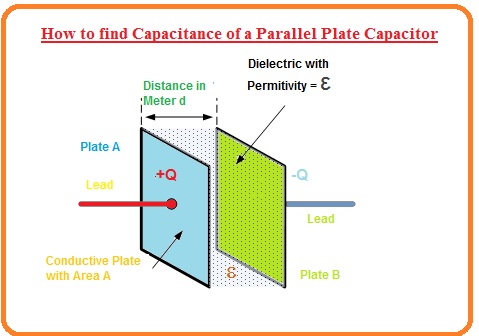
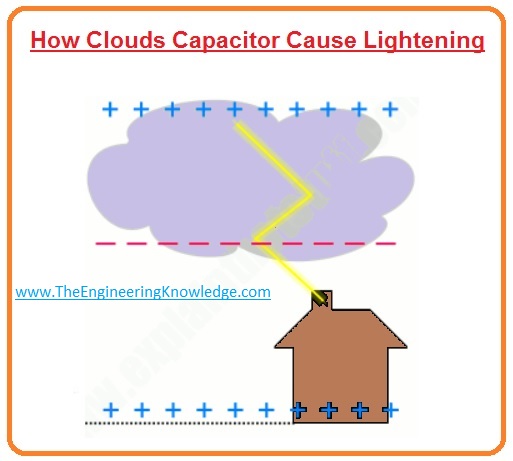






Hi there to every body, it’s my first pay a visit of this
website; this web site contains remarkable and in fact good stuff designed for readers.